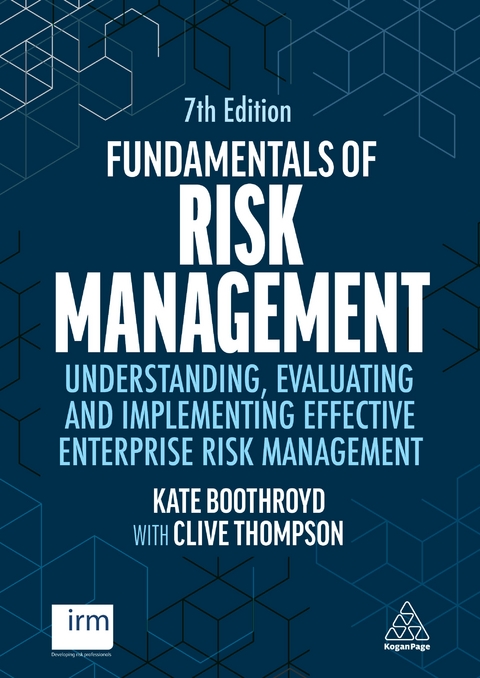
Fundamentals of Risk Management
Kogan Page Ltd (Verlag)
978-1-3986-1865-7 (ISBN)
- Noch nicht erschienen - erscheint am 03.12.2024
- Versandkostenfrei innerhalb Deutschlands
- Auch auf Rechnung
- Verfügbarkeit in der Filiale vor Ort prüfen
- Artikel merken
Fundamentals of Risk Management provides a comprehensive introduction to enterprise risk for students and risk professionals, with tools and tips, expert insights and coverage of key developments in an ever-evolving field.
Effective enterprise risk management allows organizations to maximize opportunities and minimize uncertainty. Aligned with ISO 31000, the COSO ERM Framework and the UK's Orange Book, this guide covers the key principles of risk management and how to deal with the different types of risk that organizations face. The frameworks of business continuity planning, enterprise risk management and project risk management are covered alongside an overview of international risk management standards and frameworks, strategy and policy. The text provides a clear introduction to a variety of risk management approaches used in sectors such as insurance, banking, law, health and safety and supply chain management.
Now in its seventh edition, Fundamentals of Risk Management guides readers through the steps of risk identification, risk analysis, risk description and risk estimation. It includes new chapters covering emerging trends in risk management such as resilience, sustainability and strategic risk. It offers increased international coverage around corporate governance and real-world examples, allowing students to connect theory to practice. Supporting online resources include lecture slides with figures, tables and key points from the book.
Kate Boothroyd is the Director of KB Risk Consulting Limited, a risk management consultancy. She is a Certified Fellow of the Institute of Risk Management, one of their accredited trainers and lead developer of the IRM's updated Enterprise Risk Management Certificate. She was previously Deputy Chair of the IRM. She is based in Huddersfield, UK. Clive Thompson was Deputy Chair of the IRM until 2020. He has been a risk manager and consultant delivering projects globally and is a Certified Fellow of the IRM. He is based in West Sussex, UK. The Institute of Risk Management is a world leading professional body for risk management, driving excellence in managing risk to ensure organizations are ready for opportunities and threats of the future.
Chapter - 00: Introduction
Chapter - 01: What risk is and why it is important;
Section - ONE: Introduction to risk management;
Chapter - 02: The evolution of risk management;
Chapter - 03: Risk management standards;
Section - TWO: Enterprise risk management;
Chapter - 04: Enterprise risk management;
Chapter - 05: Risk management aims and principles;
Chapter - 06: Risk management framework - risk architecture, strategy and protocols;
Chapter - 07: Roles, responsibilities and documentation;
Chapter - 08: Risk management process;
Chapter - 09: Implementing enterprise risk management;
Section - THREE: Defining context and objectives and assessing risk;
Chapter - 10: Understand the context;
Chapter - 11: Stakeholders;
Chapter - 12: Setting objectives;
Chapter - 13: Assessing risks - risk identification and articulation;
Chapter - 14: Classifying risks;
Chapter - 15: Assessing risks - risk analysis;
Chapter - 16: Different lenses for prioritizing risk;
Chapter - 17: Assessing risks - risk evaluation;
Section - FOUR: Risk response and monitor, review and report;
Chapter - 18: Managing risk;
Chapter - 19: Controlling both threats and opportunities;
Chapter - 20: Ongoing monitoring;
Chapter - 21: Ongoing review;
Chapter - 22: Reporting on risk management;
Section - FIVE: Risk strategy and culture;
Chapter - 23: Culture and behaviours;
Chapter - 24: Risk culture models and success factors;
Chapter - 25: Risk appetite and tolerance;
Chapter - 26: Risk appetite criteria and statements;
Section - SIX: Corporate governance and assurance;
Chapter - 27: Introducing corporate governance;
Chapter - 28: Compliance and the control environment;
Chapter - 29: Risk assurance;
Section - SEVEN: Organisational environment, resilience and sustainability;
Chapter - 30: Strategy and risk management;
Chapter - 31: Resilience and risk management;
Chapter - 32: Surviving shocks and disruption;
Chapter - 33: Sustainability and the risk management;
Chapter - 34: ESG and climate change;
Section - EIGHT: Different approaches;
Chapter - 35: Different approaches to risk management;
Chapter - 36: Banking, insurance and operational approaches to risk management;
Chapter - 37: Project, health and safety, legal, supply chain and IT approaches to risk management;
Chapter - 38: ERM as a translation tool;
Section - NINE: Adding value;
Chapter - 39: Maturity and continual improvement;
Chapter - 40: How risk management adds value;
Chapter - 41: Risk practitioner competencies;
Chapter - 42: How risk practitioners add value
| Erscheint lt. Verlag | 3.12.2024 |
|---|---|
| Verlagsort | London |
| Sprache | englisch |
| Maße | 170 x 240 mm |
| Themenwelt | Schulbuch / Wörterbuch ► Lexikon / Chroniken |
| Wirtschaft ► Betriebswirtschaft / Management ► Allgemeines / Lexika | |
| Wirtschaft ► Betriebswirtschaft / Management ► Unternehmensführung / Management | |
| ISBN-10 | 1-3986-1865-9 / 1398618659 |
| ISBN-13 | 978-1-3986-1865-7 / 9781398618657 |
| Zustand | Neuware |
| Haben Sie eine Frage zum Produkt? |
aus dem Bereich


